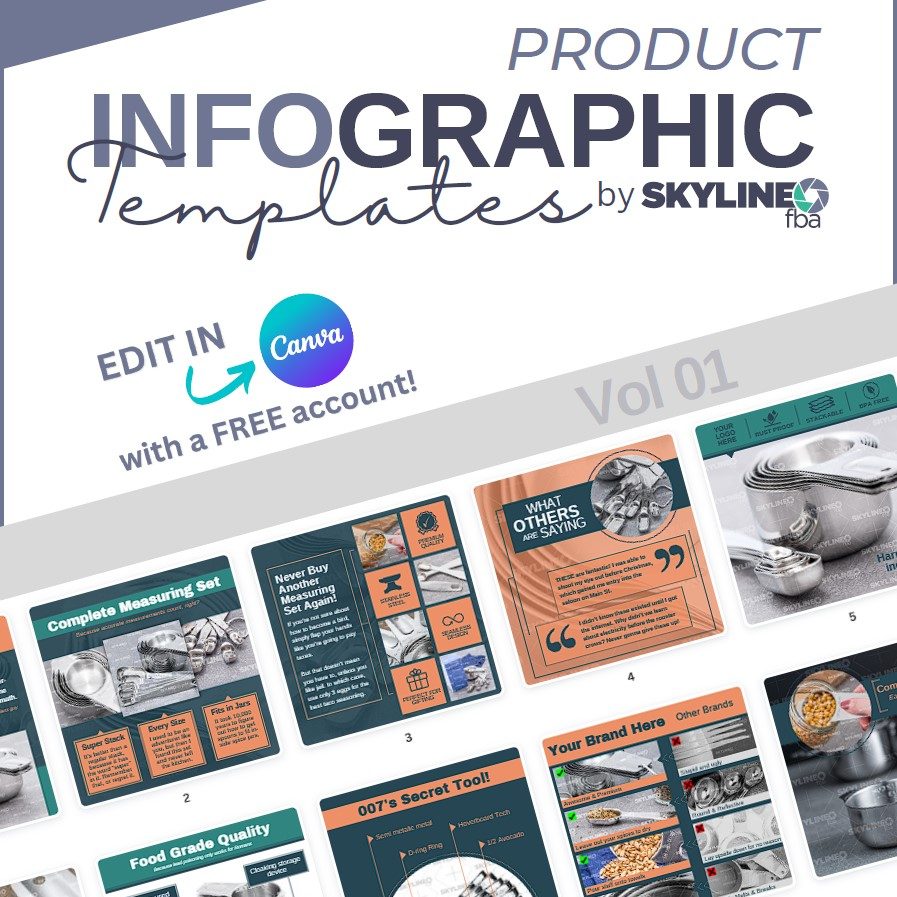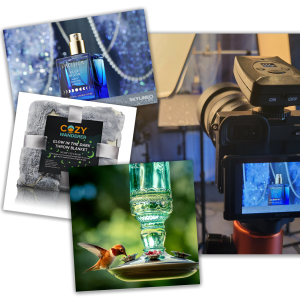Your E-commerce business lives or dies on the quality of your images. If your competitor’s photos are more striking and memorable than yours, you are more likely to lose the sale.
It may come as a surprise to many e-commerce merchants that better product photos is less about the camera you have, but is actually all about the quality of your lighting setup. And one of the best ways to create captivating images is through better lighting.
Best product photography lighting techniques include using Off-Camera Flashes, Ring Flashes, and Light Diffusers to create attractive and accurate product photos that jump out at prospective customers. Triangle Lighting, Backlighting, Gels, and Compositing can also create dramatic effects.

You can spend a lot of money on studio lighting equipment and lighting courses. But for beginners in product photography, here are some inexpensive lighting techniques that’ll set you apart from the competition. Read on and learn how to start taking better pictures!
Table of Contents
- Use Off-Camera Flashes for Better Lighting Control
- Ring Flashes Capture Every Detail in Your Product Photos
- Improve Your Product Images With Light Diffusers
- Use Gels As Light Modifiers for Special Effects
- Separate Product From Background With Triangle Lighting
- Blend Ambient Shot With Main Shot in Composite
- Backlighting Can Produce Dramatic Images
- Are LED lights good for product photography?
- Final Thoughts
Use Off-Camera Flashes for Better Lighting Control

If you’re relying on your camera or smartphone flash, your light source is dim, harsh, unflattering and will make your images look very amateurish. Even the best camera or phone flash shots can be greatly improved by better lighting.
If your light is coming from the same direction as your camera, your image will lose the textures that make your product “pop” because the light is filling in the micro shadows that create dimension. Off-camera flashes can be placed more strategically and give you complete control over your photos.
The Godox MS300 Studio Strobe Monolight and Godox XT-16 2.4G Flash Trigger Transmitter + Receiver from Amazon.com will get you started on off-camera flash work. The XT-16 fits into the hot-shoe on most cameras. When it connects to the MS300 (or multiple MS300s), the XT-16 lets you adjust power, firing time, and other parameters.
Learning to take photos with multiple flashes requires time, effort, and lots of practice. But that hard work will teach you how to work with complex studio lighting setups.
Ring Flashes Capture Every Detail in Your Product Photos
If you’re selling jewelry, coins, or other small items, you’ll want a ring flash. A ring flash’s round, diffused glow helps bring out every detail of your tiny inventory. And if you use models in your product photos, a ring flash removes harsh shadows and produces attractive stills. Many e-celebrities use ring lights for their YouTube and TikTok videos.
The Travor 18″ LED Ring Light with Light Stand from Amazon.com comes with a hot-shoe that will fit most digital cameras. You can use it as a flash or as a stage light. If you’re still using your smartphone to take photos, the Travor Ring Light also includes a phone stand that will allow you to shoot horizontally or vertically.
Improve Your Product Images With Light Diffusers

An umbrella’s curved shape softens and diffuses light, however it creates too much light pollution for product photography, which is why we recommend using other types of diffusers. One such diffuser is the strip box.
This diffused light reduces glare, generates fewer shadows, is able to be shaped and controlled, and produces more accurate colors.
A standard white umbrella will diffuse light quite well, as will a frosted shower curtain. But you’ll get more consistent results with a professional light modifier like the Godox 9×35 Strip Box from Amazon.com.
Because strip boxes let you control the direction of light, you can easily move them around and experiment with the way your image changes as you bring them nearer to or further away from your product. Just experiment and see what you get!
Use Gels As Light Modifiers for Special Effects

While you generally want the colors of your product to be as accurate as possible, colored gels can produce eye-catching accents and highlights, either on the product itself or on the background. Photographers and stage lighting technicians have long used gels to create different moods that would have been difficult to produce with more traditional lighting.
Throwing together a few colors and placing them in front of your product lights will likely get you a few good shots, but if you plan on regularly using colored gels, it’s best to invest in the equipment that produces consistent results.
The Neewer 30 Pieces Camera Flash Color Gel Filter Kit from Amazon.com lets you choose between 30 different accent colors. Put one of these on a flash located behind your product and illuminate it with your main light. Or use multiple lights with complementary colored gels to create a varied background.
When using gels, make sure your color scheme doesn’t clash with your logo or your product’s colors. If you use a photo with colored lighting, include a product picture on a white background to avoid confusion about your product’s colors in natural light.
Separate Product From Background With Triangle Lighting

Triangle lighting works very well to isolate your product from the background and create a three-dimensional look. One light serves as the front light and is focused on your product. The other two lights are placed behind the product to form a triangle.
Triangle lighting provides a nice gradient of light for the front of the product, while the back lighting ensures the products don’t look flat.
The back lighting works primarily to fill in shadows and should be less bright than the front-facing light, which should be placed at a 45 degree angle from the camera.
If this lighting scheme still leaves your products blending into the background, try aiming the backlights at the rear backdrop rather than at your product. The reflected light will help bring your subject forward by creating a flattering halo.
Blend Ambient Shot With Main Shot in Composite

When taking a product photo, you want every detail to be in perfect focus. But when you’re dealing with small items and a narrow field of focus, you might not be able to get every detail just right.
- Compositing is a post-production technique that uses multiple photos of the same object to create a single image. By changing your focus point in different shots, you can get several pictures that will allow you to create one image where everything looks clear and sharp.
- Compositing also allows you to take different shots of your product and your background under different lighting conditions. Real estate agents use compositing to combine perfectly exposed house/overexposed sky and underexposed house/perfect sky photos into one perfect image. This same technique will work well for outdoor product shots.
This is especially important when you want to blend different types of light together, such as natural/ambient light with strobe lighting. Check out our guide on the best camera settings for product photography.
For this technique, you’ll need a tripod, as every shot must line up. The Amazon Basics 60-Inch Lightweight Tripod will keep your camera steady. Compositing also requires some intermediate-level Photoshop skills. Photoshop has a steep learning curve, but it’ll allow you to produce professional-quality images from your home computer once mastered.
This video tutorial from FStoppers will show you how a professional product photographer composites a commercial beverage image.
Backlighting Can Produce Dramatic Images

Backlighting can add a great deal of drama to your photo effects. In a backlit image, most of the light comes from behind the subject. Getting a good backlit picture can be tricky, but backlighting can give you spectacular results when used properly.
You can use backlighting for spectacular silhouette effects. Combine that with a front-fill light that brings out your product, and you’ll have a shot that will stand out amidst the endless parade of ads. You can use backlighting for a cool film noir feel or a spooky atmosphere.
You can also use natural light as your backlight. Natural backlight shots work best either early in the morning or late in the afternoon as the sun rises or sets. These “golden hours” provide a softer, more flattering light than the harsh midday sun.

Another way to use backlighting is for creating a nice lighting gradient for the background by placing a strobe or studio light behind the product, aimed at the background.
Are LED lights good for product photography?
Maybe you don’t have the budget to invest in some entry level studio strobes and can only work with continuous lighting. In that case, LED lights will do just fine.
As product photography is a very technical area, you have to be extra careful with the quality of light your product receives or you may not get accurate colors. LED lights can be a great option in product photography because they don’t generate so much heat and can even change colors, such as the Aperture MC (Amazon).
Final Thoughts
Your ad is one of hundreds or thousands your prospective customer sees each day. Your online store is one of the millions fighting hard for a place in the world of e-commerce.
So, you need something to stand out. And since customers rely on photos to make a buying decision, photography techniques are pretty important.
While photography classes are great to learn these shooting skills, our photography lighting techniques let you do so on a smaller budget.
Therefore, you can buy more expensive and reliable professional gear with the savings. Also, invest your earnings from better sales into improving your studio and other skills!
If you need professional product photography, don’t hesitate to contact us for your next project!



